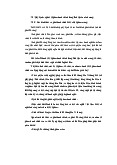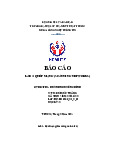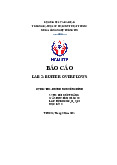













Preview text:
Lab 5. SQL Injection
SQL injection is a code injection technique that exploits the vulnerabilities in the
interface between web applications and database servers. The vulnerability is present
when user’s inputs are not correctly checked within the web applications before being
sent to the back-end database servers Submission:
You will compose a lab report that documents each step you take, including screenshots
to illustrate the effects of commands you type, and describing your observations. Simply
attaching code without any explanation will not receive credits Prepare: -
Pre-built Ubuntu VM (download from the SEED Website) LAB GUIDE: 1. Review the lab environment
-First we type this command to the terminal #vi /etc/host
->we can see a number of hosts
-next we can also type this command to create or modify many virtual hosts:
sudo vi /etc/apache2/sites-available/000-default.conf
2. Get Familiar with SQL Statements .
we have already created the Users database for you, you just need to load this
existing database using the following command:
-First, let's log in to MySQL console:
$ mysql –u root –pseedubuntu
After logging in, we'll select the existing Users database:
you can use the following command to print out all the tables of the selected database
-next we can use commands to show informations of Users:
>describe credential
-use below command to see EID, name, salary and password
> select EID, Name, Salary, Password from credential;
-After running the commands above, you need to use a SQL command to print all
the profile information of the employee Alice. Please provide the screenshot of your results:
> SELECT * FROM credential WHERE name = 'Alice';
3. SQL Injection Attack on SELECT Statement
We will use the login page from www.SEEDLabSQLInjection.com for this task
-First I open the web using this URL www.SEEDLabSQLInjection.com :
The web application authenticate users based on these two pieces of data, so only
employees who know their passwords are allowed to log in. Your job, as an attacker, is to
log into the web application without knowing any employee’s credential.
To help you started with this task, we explain how authentication is implemented
in the web application. The PHP code unsafe home.php, located in the
/var/www/SQLInjection directory, is used to conduct user authentication. The following
code snippet show how users are authenticated .
4. SQL Injection Attack from webpage.
Your task is to log into the web application as the administrator from the login
page, so you can see the information of all the employees. We assume that you do
know the administrator’s account name which is admin, but you do not the password.
You need to decide what to type in the Username and Password fields to succeed in the attack.
-We type this to the username field: admin’#
"#" is used to comment out the rest of the SQL query after "admin", effectively bypassing the password check.
This means the SQL query will return employee information for the user with the
username "admin" without verifying the password.
-we login successful and can see all the employees infos
5. SQL Injection Attack on UPDATE Statement
If a SQL injection vulnerability happens to an UPDATE statement, the damage will
be more severe, because attackers can use the vulnerability to modify databases. In
our Employee Management application, there is an Edit Profile page that allows
employees to update their profile information, including nickname, email, address, phone number, and password
When employees update their information through the Edit Profile page, the following
SQL UPDATE query will be executed. The PHP code implemented in unsafe edit
backend.php file is used to update employee’s profile information. The PHP file is
located in the /var/www/SQLInjection directory
• Task 5.1: Modify your own salary. As shown in the Edit Profile page, employees
can only update their nicknames, emails, addresses, phone numbers, and passwords;
they are not authorized to change their salaries. Assume that you (Alice) are a
disgruntled employee, and your boss Boby did not increase your salary this year. You
want to increase your own salary by exploiting the SQL injection vulnerability in the
Edit-Profile page. Please demonstrate how you can achieve that. We assume that you
do know that salaries are stored in a column called ’salary’.
-First I will go into “edit profile” section then type this command to the NickName
field in order to change salary to 1000000: ', salary='1000000' WHERE name='Alice';#
-we can see Alice salary is modify to 1000000
• Task 5.2: Modify other people’ salary. After increasing your own salary, you decide
to punish your boss Boby. You want to reduce his salary to 1 dollar. Please
demonstrate how you can achieve that.
-Similar to how I change Alice salary, Do the same with Boby by type this command
in the edit profile section: ', salary='1' WHERE Name='Boby';#
-After click save, Boby salary has been nodify to 1
• Task 5.3: Modify other people’ password. After changing Boby’s salary, you are
still disgruntled, so you want to change Boby’s password to something that you know,
and then you can log into his account and do further damage. Please demonstrate how
you can achieve that. You need to demonstrate that you can successfully log into
Boby’s account using the new password. One thing worth mentioning here is that the
database stores the hash value of passwords instead of the plaintext password string.
You can again look at the unsafe edit backend.php code to see how password is being
stored. It uses SHA1 hash function to generate the hash value of password.
-Do the same step but this time we change the password, type this command to profile
edit: ', Password='123456' WHERE Name='Alice';#
-this command is used to change Alice ‘s password to 123456
-we can see in the database that Alice ’s password is changed to ‘123456’ but it not
sha1 Hashed so we need to modified it to sha1 value of ‘123456’
-to find the sha1 hash value we use openssl:
-after get the sha1 hash value now we repeat the upper steps to change password to the sha1 hash value:
',Password='7c4a8d09ca3762af61e59520943dc26494f8941b' where Name='Alice';#
-we successful change the password now try to login to Alice account with the password ‘123456’: ->login successful




